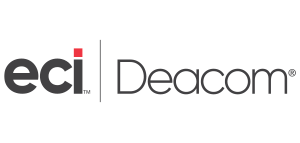
Sponsored by ECI Software

Do you want to optimize production, reduce waste, meet customer demand, lower labor costs, and improve supply chain efficiency? Then look to your warehouse. The market for warehouse management systems is expected to grow at a CAGR of 15% through 2030 as manufacturing companies realize the many benefits of digitizing their warehouse operations.
As an example, Silver Spring Foods reduced their inventory variance by 99% after implementing Deacom ERP with its integrated warehouse management system. In just a couple of years, Silver Spring went from a $300,000 variance on $4 million in inventory down to just $1,700 in variance on $14 million in inventory.

To learn more about how integrated warehouse management can help food and beverage manufacturers achieve these kinds of results, I spoke with Chris Conroy, a senior sales engineer with ECI Software Solutions, which makes Deacom ERP. Conroy has been with the company for more than 15 years, and in that time, he has worked on all aspects of the product, from development to implementation and support.
Let’s start at the beginning. What is a warehouse management system?
Chris Conroy: A warehouse management system, or WMS, is any software application or platform that’s specifically designed to optimize and control warehouse operations. That includes inventory tracking, managing stock levels and locations, moving inventory through the warehouse, etc. For batch and process manufacturers like food and beverage, it also enables lot traceability because, at the end of the day, they need to be able to track raw materials through the production process all the way through getting the finished product out the door to the customer.
Companies that haven’t yet adopted a WMS are typically using pen and paper. That means someone is recording lot numbers as they come in and then handing the paper to someone else who types it into a computer.
That sounds time-consuming and also like there would be a lot of mistakes. When is the right time in a company’s growth to move from pen and paper to digital warehouse management?
CC: What it boils down to is the complexity of your business. You can have a very simple process that you can manage in Excel, and, if your process doesn’t change, that spreadsheet can take you pretty far. But as your complexity and data footprint grow, and you start needing to create another Excel spreadsheet or another Access database, that’s when you need a WMS.
Another factor that’s driving the need for ERP and WMS is regulations. Traceability regulations, especially, are leading food and beverage manufacturers to embrace this type of technology.
What are the key functions of WMS for the food and beverage industry?
CC: At a high level, inventory tracking and strict process control – this helps with order processing, picking, and packing. When inventory comes in, a WMS can tell you where in the warehouse to put it, and then when you go to pick it, the system can help you maintain FEFO (first expire, first out). In the food and beverage world, this is crucial because expiring product is just a waste of money. Some of our customers deal with fresh products like produce, seafood, and meat, so they measure shelf life in single days. It also prevents you from shipping lots that are on hold for quality control. Lot validation takes the guesswork out of the end user’s hands.
The next big function is location validation. Imagine you have a perishable item that needs to be stored in a refrigerated environment. In Deacom, we can establish rules for what products can go in what locations, which we refer to as zones. If a user scans an item that’s not in the right zone, the system will let them know. These zones also help prevent cross-contamination of allergens, organic and non-organic products, and so on.
Ultimately, the WMS evolved from lot tracking – the ability to know what went where – and now we’re making it smarter to make sure the user is putting inventory in the right spot and picking the right lots, among other things.
WMS also enables full traceability because anytime a lot is used, it’s scanned and tracked, from raw material through processing, packaging, finishing, and out the door to the customer. As part of our implementation process for Deacom, we run a mock recall. Say a vendor calls and says a lot is bad and needs to be recalled. We can input that vendor’s lot number and within a couple of seconds have a bidirectional report of everywhere that lot was used, meaning that we see all of the raw materials that went into it, to get a better idea of what happened.
Let’s dive into the benefits. What are the main challenges this kind of software solves?
CC: I mentioned minimizing waste, which can be a significant cost saving, especially if you’re dealing with perishable goods. The biggest benefit is accurate and real-time inventory tracking, which tells you whether or not you can fulfill a customer’s demand now or if you have to start the manufacturing process to make sure you have inventory.
A WMS also helps you optimize your stock levels for raw materials. For example, maybe there is a seasonality aspect to your inventory. With WMS, you can minimize stock-outs by not running out of inventory, but also reduce costs by avoiding overstocking. Basically, it streamlines your order fulfillment process, which is a huge benefit in the food and beverage industry.
In addition, WMS lets you optimize your warehouse transfers, even for outside warehouses. Almost every customer we interact with now uses a third-party logistics provider (3PL) and outside warehouses for cold storage. Our WMS is all wireless and on handheld devices, so you can take it anywhere as long as you have an internet connection.
It sounds like what a WMS really does is help companies work smarter, not harder, which also helps them tackle the ongoing challenge of the labor shortage.
CC: Certainly. We talked a little bit earlier about the inefficiencies of a pen and paper system. Another advantage where we’re seeing a lot of benefits from a labor perspective is consolidated picking. Many of our customers have items that are shared across several different formulas. If your system isn’t automated, then you probably have someone going out batch by batch, picking orders one at a time. With our WMS, you can group jobs that use similar items or are in the same work area so you only have to go to the warehouse once rather than making multiple trips.
Another labor benefit is eliminating non-value-added work. The amount of non-value-added work that is required by non-automated systems can be astronomical. One example in facilities that produce catch weight items is writing down weights.
I work with a meat manufacturer in Alabama that makes hams, and before implementing our WMS, someone would have to write down the weights of all of the hams. We have a tool called the AutoFinisher, which allows you to connect a scale to the Deacom application and automatically record the weight of products and have that information tied to the barcode. Now that manufacturer can track every ham – and its weight – all the way to their customers. This eliminates the work of writing down weights as well as the errors inherent in a manual process that can lead to invoicing problems and customer complaints.
We’ve been talking about WMS systems in general. Now let’s shift to the idea of integration. What are the benefits of having a WMS integrated into your ERP system?
CC: The main benefit is real-time data transfer. With a bolt-on approach, there will always be a delay in the communication between the systems, which can introduce potential inaccuracies. What if one system updates and the other one doesn’t?
With Deacom, we built the WMS organically into the ERP. What that means is that the systems share the same core architecture. We have a few different skins (a web-based system, mobile apps, etc.) and different pieces of functionality for different devices, but every one of them uses the same base code and the same database. This means, for example, that when someone hits “save” in the web browser to receive inventory, someone else on the handheld WMS will immediately see that inventory as an available lot that they can pick. There’s no lag.
Another big advantage of this integration is our ability to maintain deployment. Installing the system takes about 5 minutes and an update takes less than 1 minute because everything uses the same core system. This gives us a distinct advantage.
What else sets Deacom apart?
CC: There are three key things. The first is what I just mentioned – it’s all one system. We have the largest set of native software capabilities for the food and beverage industry. A lot of companies say they’re one system, but when you start to peel back the layers, you see that they’re actually different pieces that were acquired over the years and bolted on.
Next, we’re one team. Deacom doesn’t have different people who sell versus implement versus support. We’re all part of the same team and we are in constant communication.
And third, as a Deacom customer, you’re part of that team. You won’t be customer #19872 – we don’t have customer numbers. Once you talk to a member of our support team, you’ll be on a first-name basis.
Any final stories you’d like to share?
CC: How much time do you have? I’m only kidding, but, yes, I have one more story. With a WMS we mostly talk about inventory, inventory, inventory. But we have a customer who’s a beverage manufacturer in Charlotte, North Carolina, that was able to use our WMS to improve their production process. They would finish pallets of soda and move them to multiple warehouses in their complex, and they were using pen and paper to track inventory, so once the soda left the production floor, they didn’t know where it was or what truck it was on. At the receiving dock, someone would write down that they received X cases of the product, and that was that.
Our WMS enabled the customer to transform this process. Instead of losing sight of the product, they now print barcodes as the pallets are being finished, which means they can track those pallets onto the truck and into the warehouse. Essentially, we took this huge gap where they didn’t know what was happening and gave them tools to visualize every step of the process.
That sounds like something every food and beverage manufacturer could use! Thank you, Chris.
CC: Thank you.



![[eBook] Expert Roundtable: Supply Chain Resilience and Contingency Planning for Food and Beverage Businesses](https://foodindustryexecutive.com/wp-content/uploads/2024/07/Sponsored-Resource-Image-900x600-July-7-218x150.webp)
![[Guide] Leveraging Real-Time Quality and Production Data to Drive Better Results](https://foodindustryexecutive.com/wp-content/uploads/2024/06/Real-Time-Quality-Production-Data-218x150.png)
![[Checklist] Connected Workforce Solution Checklist – 7 Must-Haves](https://foodindustryexecutive.com/wp-content/uploads/2024/06/RZ_Resource_900x600-218x150.jpg)

